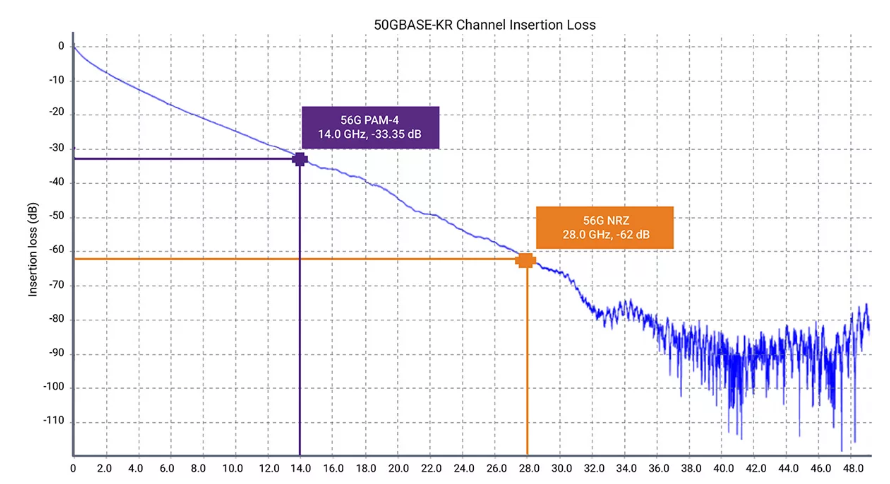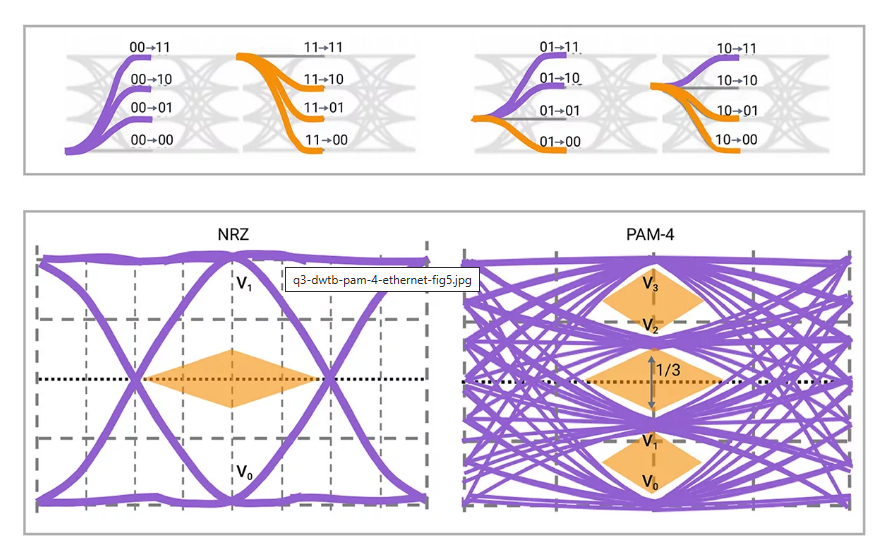Reasons and advantages of switching to PAM-4 signalling instead of NRZ for 400G Ethernet
With the development of the Internet and the demand for data centres and cloud computing, the speed and bandwidth of network transmission have been increasing. Currently, 100G Ethernet has become the mainstream standard for data centres, but with the emergence of new technologies such as 5G, IoT, and AI, 100G Ethernet can no longer meet future needs, and 400G Ethernet has become the new target. However, to achieve 400G Ethernet, traditional NRZ (non-return-to-zero) signalling is no longer sufficient because it has the same baud rate (number of symbols transmitted per second) and bit rate (number of bits transmitted per second), which means that each symbol can only carry one bit of information. To achieve a higher bit rate at the same baud rate, it is necessary to use a higher-order modulation, such as PAM-4 (Pulse Amplitude Modulation, 4th order) signalling, which can carry two bits of information per symbol, thus achieving twice the bit rate. Therefore, switching to PAM-4 signalling instead of NRZ signalling for 400G Ethernet is an effective way to improve transmission efficiency and reduce costs.
The principle of PAM-4 signalling is to divide the voltage into four different levels, corresponding to four states, 00, 01, 10 and 11, with each state representing two bits of information. For example, if the voltage is 0V, it means 00, if the voltage is 0.5V, it means 01, if the voltage is 1V, it means 10, and if the voltage is 1.5V, it means 11. In this way, each symbol transmits two bits of information, and the bit rate is twice the baud rate. For example, if the baud rate is 25 Gbaud, then the bit rate is 50 Gbps. in this way, only 8 PAM-4 channels are needed to achieve a transmission rate of 400 Gbps, whereas if NRZ signalling is used, 16 NRZ channels are needed, which increases the complexity and cost.

The advantage of PAM-4 signalling is that it can achieve twice the bit rate at the same baud rate, which means that more data can be transmitted using a lower baud rate and a narrower frequency band, thus increasing transmission efficiency and reducing costs. For example, to achieve a 400Gbps transmission rate using NRZ signalling, a baud rate of 56Gbaud and a frequency band of 112GHz would be required, whereas with PAM-4 signalling, only a baud rate of 28Gbaud and a frequency band of 56GHz would be required, which saves half of the resources. In addition, PAM-4 signalling is compatible with existing optical fibre and optical modules, eliminating the need for hardware replacement, and only requiring the addition of PAM-4 codecs at the transceiver end to enable 400G Ethernet transmission.

However, PAM-4 signalling has some challenges, mainly signal quality assurance. Since the level spacing of PAM-4 signalling is half that of NRZ signalling, this results in a higher sensitivity to voltage noise, requiring a more accurate voltage reference and better power management. Also, the eye diagram (a graphical representation of the signal waveform) of PAM-4 signalling has three eyes, while NRZ signalling has only one eye, which means that the signal quality of PAM-4 signalling is more difficult to guarantee, requiring a higher signal-to-noise ratio and a lower bit error rate. In order to solve these problems, it is necessary to use some high-performance, low-power, low-cost design tools and IP products, such as PHY IP, Controller IP, Verification IP, DesignWare Library, etc., provided by Synopsys, which can help customers to achieve efficient, reliable and secure PAM-4 signalling solutions.

Switching to PAM-4 signalling instead of NRZ signalling for 400G Ethernet is a future-proof technology choice that can achieve twice the bit rate at the same baud rate, thus improving transmission efficiency and reducing costs. However, PAM-4 signalling also has some signal quality challenges that need to be addressed using some advanced design tools and IP products.
With the development of the Internet and the demand for data centres and cloud computing, the speed and bandwidth of network transmission have been increasing. Currently, 100G Ethernet has become the mainstream standard for data centres, but with the emergence of new technologies such as 5G, IoT, and AI, 100G Ethernet can no longer meet future needs, and 400G Ethernet has become the new target. However, to achieve 400G Ethernet, traditional NRZ (non-return-to-zero) signalling is no longer sufficient because it has the same baud rate (number of symbols transmitted per second) and bit rate (number of bits transmitted per second), which means that each symbol can only carry one bit of information. To achieve a higher bit rate at the same baud rate, it is necessary to use a higher-order modulation, such as PAM-4 (Pulse Amplitude Modulation, 4th order) signalling, which can carry two bits of information per symbol, thus achieving twice the bit rate. Therefore, switching to PAM-4 signalling instead of NRZ signalling for 400G Ethernet is an effective way to improve transmission efficiency and reduce costs.
The principle of PAM-4 signalling is to divide the voltage into four different levels, corresponding to four states, 00, 01, 10 and 11, with each state representing two bits of information. For example, if the voltage is 0V, it means 00, if the voltage is 0.5V, it means 01, if the voltage is 1V, it means 10, and if the voltage is 1.5V, it means 11. In this way, each symbol transmits two bits of information, and the bit rate is twice the baud rate. For example, if the baud rate is 25 Gbaud, then the bit rate is 50 Gbps. in this way, only 8 PAM-4 channels are needed to achieve a transmission rate of 400 Gbps, whereas if NRZ signalling is used, 16 NRZ channels are needed, which increases the complexity and cost.

The advantage of PAM-4 signalling is that it can achieve twice the bit rate at the same baud rate, which means that more data can be transmitted using a lower baud rate and a narrower frequency band, thus increasing transmission efficiency and reducing costs. For example, to achieve a 400Gbps transmission rate using NRZ signalling, a baud rate of 56Gbaud and a frequency band of 112GHz would be required, whereas with PAM-4 signalling, only a baud rate of 28Gbaud and a frequency band of 56GHz would be required, which saves half of the resources. In addition, PAM-4 signalling is compatible with existing optical fibre and optical modules, eliminating the need for hardware replacement, and only requiring the addition of PAM-4 codecs at the transceiver end to enable 400G Ethernet transmission.

However, PAM-4 signalling has some challenges, mainly signal quality assurance. Since the level spacing of PAM-4 signalling is half that of NRZ signalling, this results in a higher sensitivity to voltage noise, requiring a more accurate voltage reference and better power management. Also, the eye diagram (a graphical representation of the signal waveform) of PAM-4 signalling has three eyes, while NRZ signalling has only one eye, which means that the signal quality of PAM-4 signalling is more difficult to guarantee, requiring a higher signal-to-noise ratio and a lower bit error rate. In order to solve these problems, it is necessary to use some high-performance, low-power, low-cost design tools and IP products, such as PHY IP, Controller IP, Verification IP, DesignWare Library, etc., provided by Synopsys, which can help customers to achieve efficient, reliable and secure PAM-4 signalling solutions.

Switching to PAM-4 signalling instead of NRZ signalling for 400G Ethernet is a future-proof technology choice that can achieve twice the bit rate at the same baud rate, thus improving transmission efficiency and reducing costs. However, PAM-4 signalling also has some signal quality challenges that need to be addressed using some advanced design tools and IP products.







